Forecasting Urban Peak Water Demand Based on Climate Indices and Demographic Trends
Abstract
:1. Introduction
2. Materials
2.1. Study Site
2.2. Climate Indices
3. Methods
3.1. Data Preparation
3.2. Model Building
3.3. Model Performance
3.4. Long-Term Water Demand Estimation Considering Climate Change and Demographic Development
4. Results and Discussion
4.1. Model Building
- Mean temperature
- Maximum temperature
- Hot days
- Summer days
- Heat waves
- Consecutive dry days
- Consecutive wet days
- Day of the week
- Month
- Dry summer days
- Dry periods
- Maximum temperature: month
- Mean temperature: month
4.2. Model Performance
4.3. Long-Term Water Demand Estimation Considering Climate Change and Demographic Development
5. Conclusions
Author Contributions
Funding
Data Availability Statement
Acknowledgments
Conflicts of Interest
References
- Dimkić, D. Temperature Impact on Drinking Water Consumption. Environ. Sci. Proc. 2020, 2, 31. [Google Scholar] [CrossRef]
- Wang, X.; Zhang, J.; Shahid, S.; Guan, E.; Wu, Y.; Gao, J.; He, R. Adaptation to Climate Change Impacts on Water Demand. Mitig. Adapt. Strateg. Glob. Chang. 2016, 21, 81–99. [Google Scholar] [CrossRef]
- Ashoori, N.; Dzombak, D.A.; Small, M.J. Modeling the Effects of Conservation, Demographics, Price, and Climate on Urban Water Demand in Los Angeles, California. Water Resour. Manag. 2016, 30, 5247–5262. [Google Scholar] [CrossRef]
- Murdock, S.H.; Albrecht, D.E.; Hamm, R.R.; Backman, K. Role of Sociodemographic Characteristics in Projections of Water Use. J. Water Resour. Plan. Manag. 1991, 117, 235–251. [Google Scholar] [CrossRef]
- Timotewos, M.T.; Barjenbruch, M.; Behailu, B.M. The Assessment of Climate Variables and Geographical Distribution on Residential Drinking Water Demand in Ethiopia. Water 2022, 14, 1722. [Google Scholar] [CrossRef]
- Neunteufel, R.; Richard, L.; Perfler, R. Wasserverbrauch und Wasserbedarf; Bundesministerium für Land- und Forstwirtschaft, Umwelt und Wasserwirtschaft: Wien, Austria, 2012.
- Donkor, E.A.; Mazzuchi, T.A.; Soyer, R.; Alan Roberson, J. Urban Water Demand Forecasting: Review of Methods and Models. J. Water Resour. Plan. Manag. 2014, 140, 146–159. [Google Scholar] [CrossRef]
- de Souza Groppo, G.; Costa, M.A.; Libânio, M. Predicting Water Demand: A Review of the Methods Employed and Future Possibilities. Water Supply 2019, 19, 2179–2198. [Google Scholar] [CrossRef]
- Adamowski, J.; Chan, H.; Prasher, S.; Ozga-Zielinski, B.; Sliusarieva, A. Comparison of Multiple Linear and Nonlinear Regression, Autoregressive Integrated Moving Average, Artificial Neural Network, and Wavelet Artificial Neural Network Methods for Urban Water Demand Forecasting in Montreal, Canada. Water Resour. Res. 2012, 48, 1528. [Google Scholar] [CrossRef]
- Stelzl, A.; Pointl, M.; Fuchs-Hanusch, D. Estimating Future Peak Water Demand with a Regression Model Considering Climate Indices. Water 2021, 13, 1912. [Google Scholar] [CrossRef]
- Adamowski, J. Peak Daily Water Demand Forecast Modeling Using Artificial Neural Networks. J. Water Resour. Plan. Manag. 2008, 134, 119–128. [Google Scholar] [CrossRef]
- Ghiassi, M.; Zimbra David, K.; Saidane, H. Urban Water Demand Forecasting with a Dynamic Artificial Neural Network Model. J. Water Resour. Plan. Manag. 2008, 134, 138–146. [Google Scholar] [CrossRef]
- Vonk, E.; Cirkel, D.G.; Blokker, M. Estimating Peak Daily Water Demand under Different Climate Change and Vacation Scenarios. Water 2019, 11, 1874. [Google Scholar] [CrossRef]
- Bakker, M.; van Duist, H.; van Schagen, K.; Vreeburg, J.; Rietveld, L. Improving the Performance of Water Demand Forecasting Models by Using Weather Input. Procedia Eng. 2014, 70, 93–102. [Google Scholar] [CrossRef]
- Donevska, K.; Panov, A. Climate Change Impact on Water Supply Demands: Case Study of the City of Skopje. Water Supply 2019, 19, 2172–2178. [Google Scholar] [CrossRef]
- Fiorillo, D.; Kapelan, Z.; Xenochristou, M.; De Paola, F.; Giugni, M. Assessing the Impact of Climate Change on Future Water Demand Using Weather Data. Water Resour. Manag. 2021, 35, 1449–1462. [Google Scholar] [CrossRef]
- Rasifaghihi, N.; Li, S.S.; Haghighat, F. Forecast of Urban Water Consumption under the Impact of Climate Change. Sustain. Cities Soc. 2020, 52, 101848. [Google Scholar] [CrossRef]
- GeoSphere Austria Data Hub. Available online: https://data.hub.geosphere.at/group/stationsdaten (accessed on 29 November 2023).
- Intergovernmental Panel on Climate Change (IPCC). Climate Change 2013—The Physical Science Basis: Working Group I Contribution to the Fifth Assessment Report of the Intergovernmental Panel on Climate Change; Cambridge University Press: Cambridge, UK, 2014; ISBN 978-1-107-05799-9. [Google Scholar]
- Moss, R.H.; Edmonds, J.A.; Hibbard, K.A.; Manning, M.R.; Rose, S.K.; van Vuuren, D.P.; Carter, T.R.; Emori, S.; Kainuma, M.; Kram, T.; et al. The next Generation of Scenarios for Climate Change Research and Assessment. Nature 2010, 463, 747–756. [Google Scholar] [CrossRef] [PubMed]
- Leuprecht, A.; Chimani, B.; Heinrich, G.; Hofstätter, M.; Kerschbaumer, M.; Kienberger, S.; Lexer, A.; Peßenteiner, S.; Poetsch, M.; Salzmann, M.; et al. OKS15 Bias Corrected EURO-CORDEX Models, 2nd ed.; CCCA Data Centre: Vienna, Austria; Available online: https://data.ccca.ac.at/group/oks15 (accessed on 20 December 2023).
- Mendlik, T.; Chimani, B.; Matulla, C.; Eitzinger, J.; Hiebl, J.; Hofstätter, M.; Kubu, G.; Maraun, D.; Schellander-Gorgas, T.; Thaler, S. STARC-Impact Bias Corrected ENSEMBLES, 1st ed.; CCCA Data Centre: Vienna, Austria; Available online: https://data.ccca.ac.at/group/starc-impact (accessed on 20 December 2023).
- Chimani, B.; Heinrich, G.; Hofstätter, M.; Kerschbaumer, M.; Kienberger, S.; Leuprecht, A.; Lexer, A.; Peßenteiner, S.; Poetsch, M.S.; Salzmann, M.; et al. and Truhetz, H. ÖKS15—Klimaszenarien für Österreich; Daten, Methoden Und Klimaanalyse; Federal Ministry Climate Action, Environment, Energy, Mobility, Innovation and Technology: Wien, Austria, 2016.
- Welcome|CCCA Data Server. Available online: https://data.ccca.ac.at/ (accessed on 4 November 2023).
- Jacob, D.; Petersen, J.; Eggert, B.; Alias, A.; Christensen, O.B.; Bouwer, L.M.; Braun, A.; Colette, A.; Déqué, M.; Georgievski, G.; et al. EURO-CORDEX: New High-Resolution Climate Change Projections for European Impact Research. Reg. Environ. Chang. 2014, 14, 563–578. [Google Scholar] [CrossRef]
- European Climate Assesment & Dataset Indices Dictionary. Available online: https://www.ecad.eu/indicesextremes/indicesdictionary.php#3 (accessed on 21 December 2023).
- DataCamp Boxplot. Stats: Box Plot Statistics. Available online: https://www.rdocumentation.org/packages/grDevices/versions/3.6.2/topics/boxplot.stats (accessed on 30 November 2023).
- Bevölkerung Stadtregion Wels|Stadtregionen. Available online: https://www.stadtregionen.at/wels/bev%C3%B6lkerung (accessed on 19 December 2023).
- Statistik Austria—Gemeinden. Available online: https://www.statistik.at/blickgem/gemDetail.do?gemnr=40301 (accessed on 19 December 2023).
- Statistiken der Landeshauptstadt Graz—Stadtportal der Landeshauptstadt Graz. Available online: https://www.graz.at/cms/beitrag/10104210/7749761/Statistiken_der_Landeshauptstadt_Graz.html (accessed on 19 December 2023).
- ÖROK-Regionalprognosen 2021–2050: Bevölkerung; Geschäftsstelle der Österreichischen Raumordnungskonferenz (ÖROK) (Ed.) Österreichische Raumordnungskonferenz: Wien, Austria, 2022; ISBN 978-3-9519791-5-1.
- Statistik Austria. Bevölkerungsprognosen für Österreich und Die Bundesländer. Available online: https://www.statistik.at/statistiken/bevoelkerung-und-soziales/bevoelkerung/demographische-prognosen/bevoelkerungsprognosen-fuer-oesterreich-und-die-bundeslaender (accessed on 30 October 2023).
- Gedefaw, M.; Hao, W.; Denghua, Y.; Girma, A. Variable Selection Methods for Water Demand Forecasting in Ethiopia: Case Study Gondar Town. Cogent Environ. Sci. 2018, 4, 1537067. [Google Scholar] [CrossRef]
- United Nations Climate Action. Available online: https://www.un.org/sustainabledevelopment/climate-action/ (accessed on 30 November 2023).
- United Nations Take Action for the Sustainable Development Goals. Available online: https://www.un.org/sustainabledevelopment/sustainable-development-goals/ (accessed on 30 November 2023).
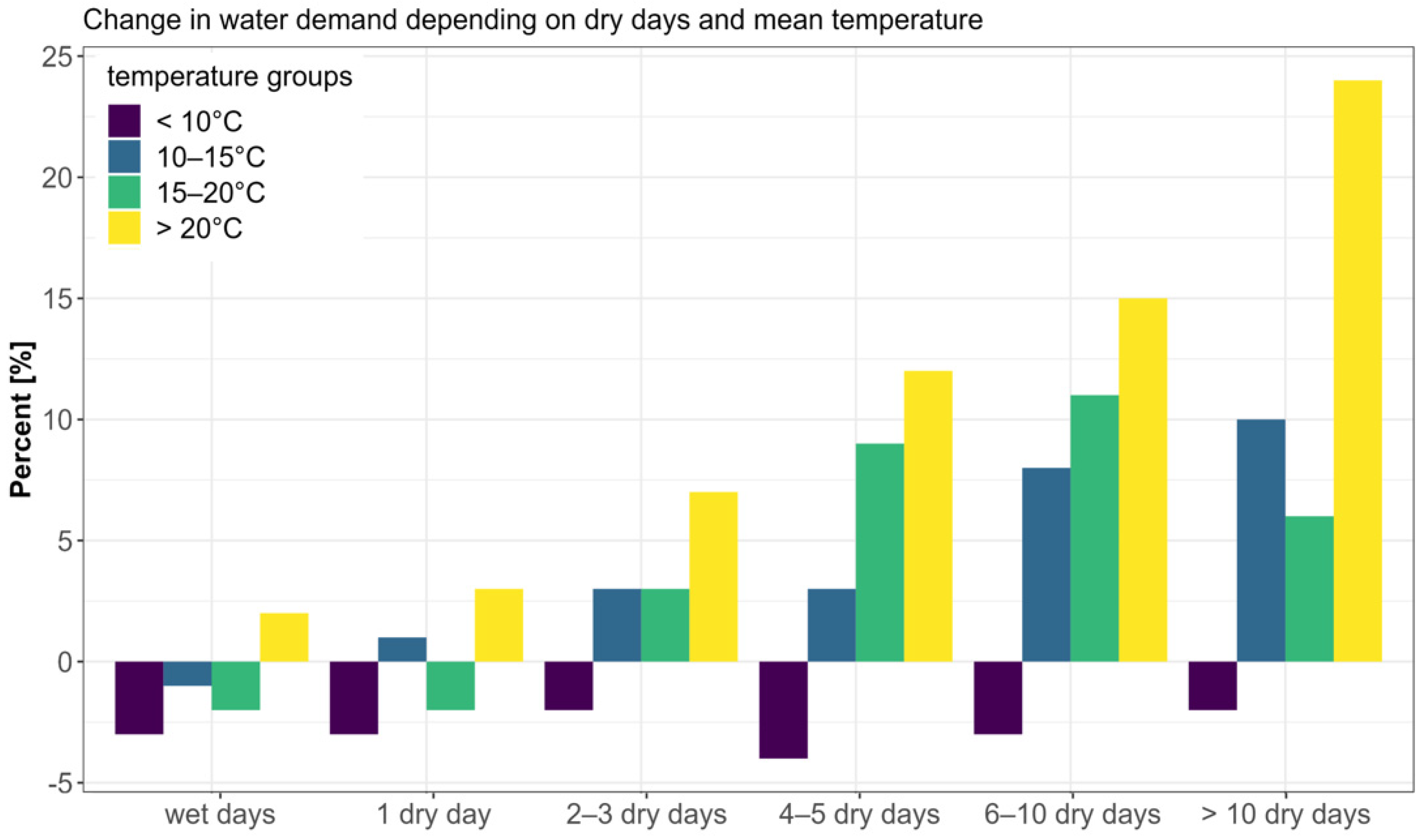
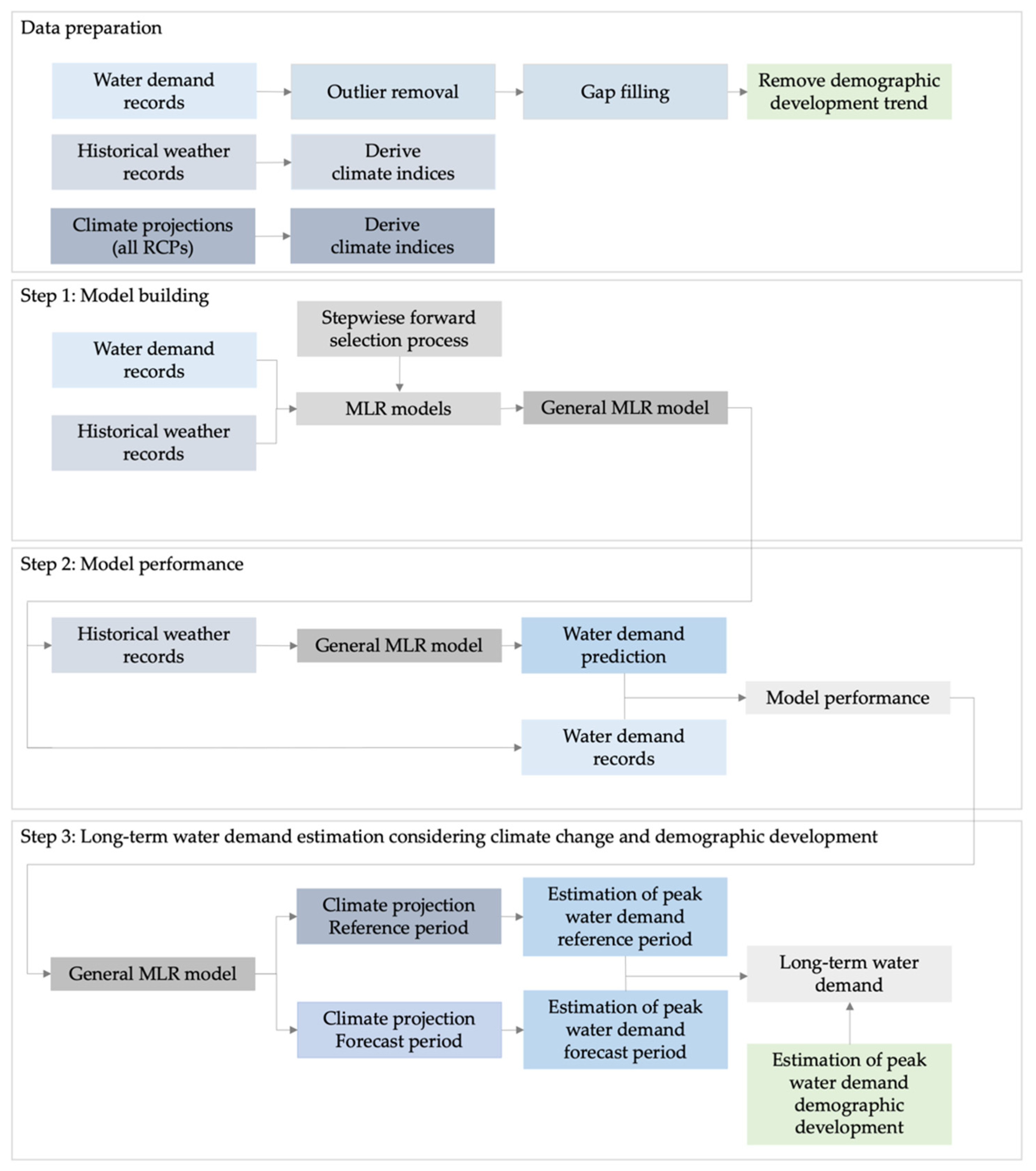
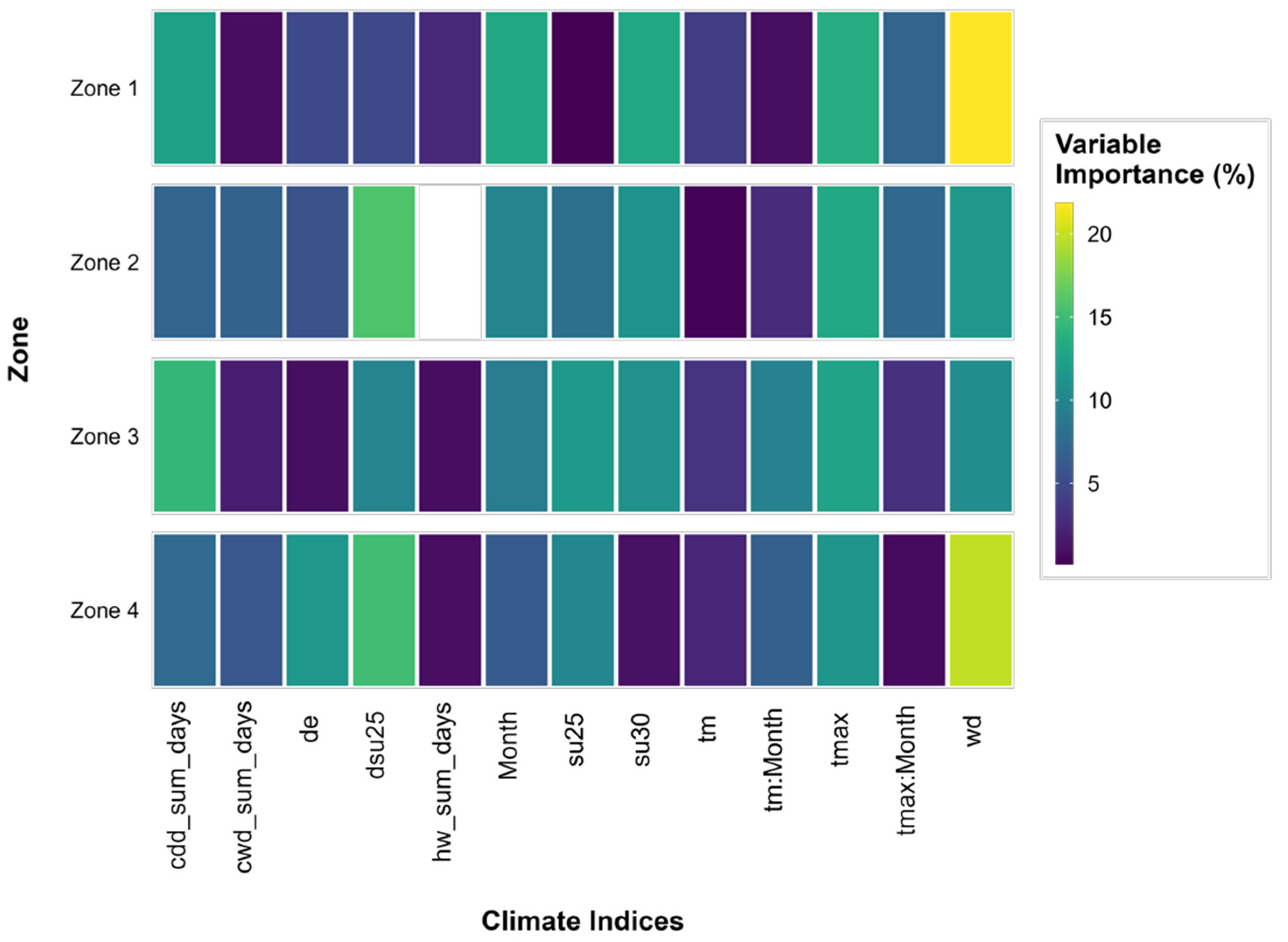

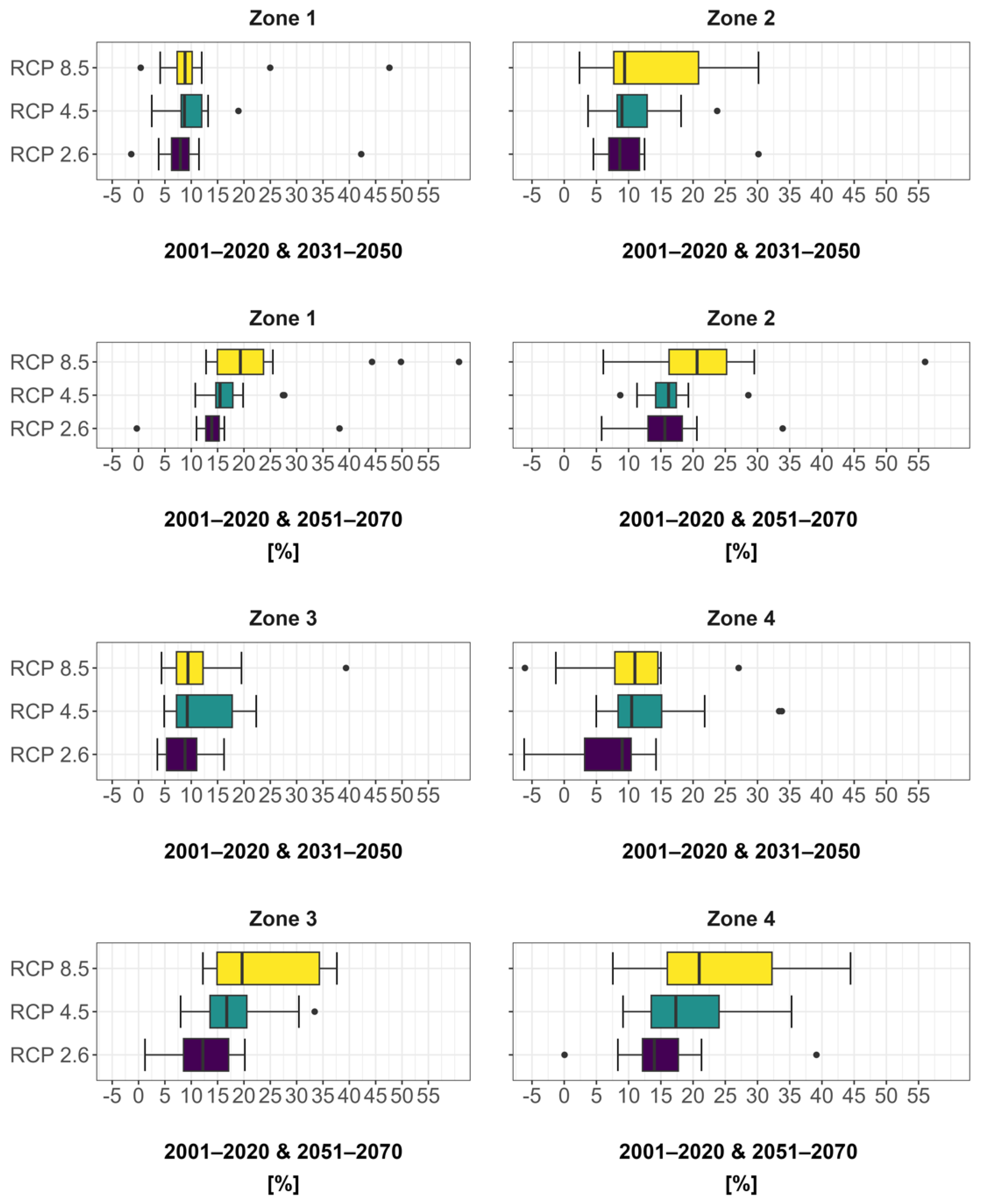
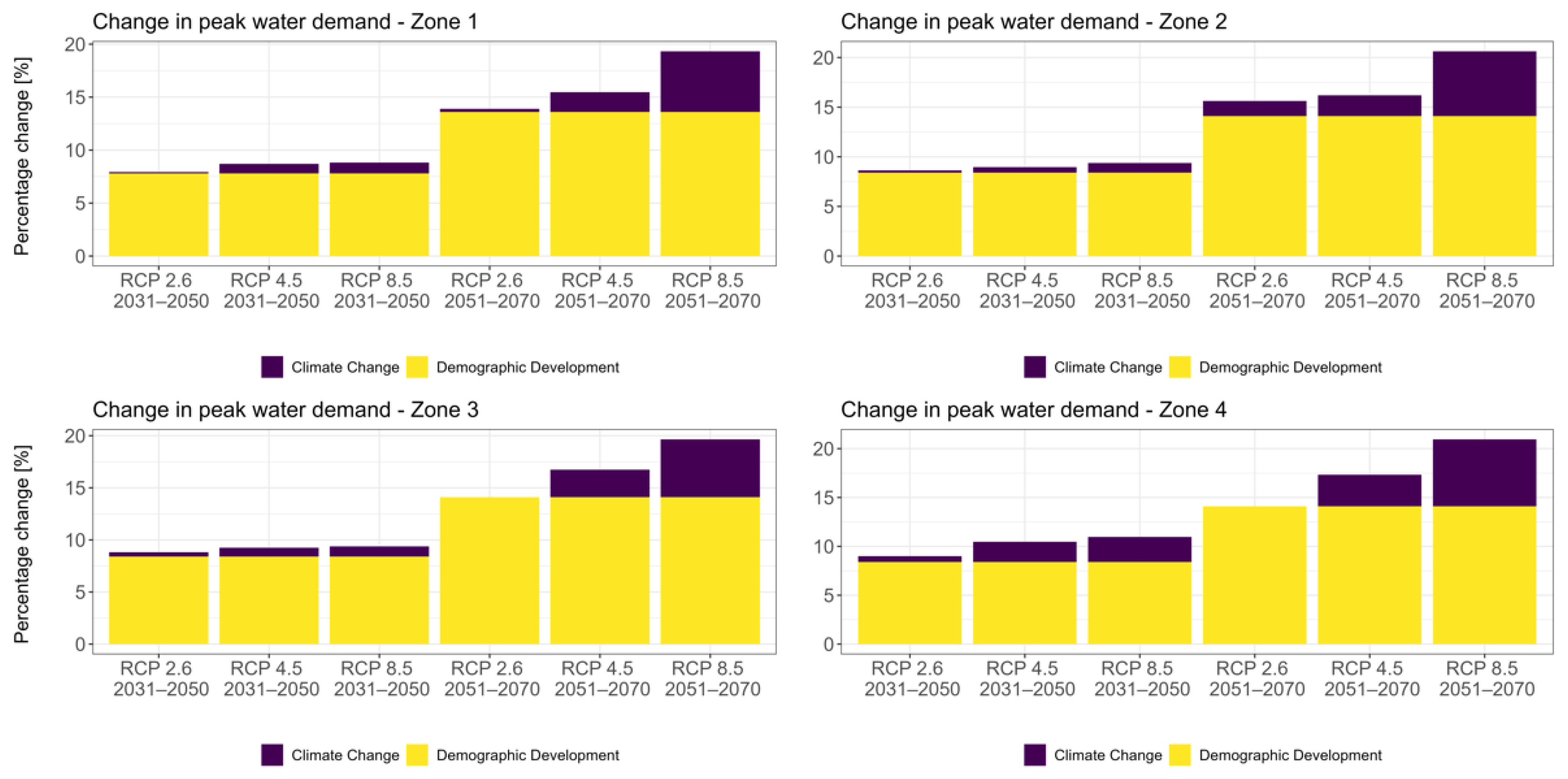
| Climate Indices | Abbreviation | Description |
|---|---|---|
| Air temperature (°C) | tm | Mean temperature [23] |
| Hot days (days) | su30 | Days with a maximum temperature of more than 30.0 °C [23] |
| Summer days (days) | su25 | Days with a maximum temperature of more than 25.0 °C [23,26] |
| Heat waves (days) | hw_sum_days | A period of at least three days with a daily maximum temperature of more than 30.0 °C and a daily minimum temperature of at least 18.0 °C [23] |
| Consecutive dry days (days) | cdd_sum_days | An episode lasting at least five days with a precipitation amount of less than 1 mm [23,26] |
| Consecutive wet days (days) | cwd_sum_days | An episode lasting at least three days with a precipitation amount of at least 1 mm [23,26] |
| Climate Indices | Abbreviation | Description |
|---|---|---|
| Maximum air temperature (°C) | tmax | Maximum temperature |
| Minimum air temperature (°C) | tmin | Minimum temperature |
| Dry hot days (days) | dsu30 | Days with a maximum temperature of more than 30.0 °C and a precipitation amount of less than 1 mm |
| Dry summer days (days) | dsu25 | Days with a maximum temperature of more than 25.0 °C and a precipitation amount of less than 1 mm |
| Dry heat waves (days) | dhw | A period of at least three days with a daily maximum temperature of more than 30.0 °C and a daily minimum temperature of less than 18.0 °C and a precipitation amount of less than 1 mm |
| Dry period (days) | de | An episode that is only interrupted if there is more than 1 mm of precipitation on three consecutive days. |
| Zone | MAPE (%) | r (-) |
|---|---|---|
| Zone 1 | 4.4 | 0.78 |
| Zone 2 | 8.1 | 0.69 |
| Zone 3 | 8.9 | 0.62 |
| Zone 4 | 9.0 | 0.71 |
| Zone | MAPE (%) | r (-) |
|---|---|---|
| Zone 1 | 4.7 | 0.78 |
| Zone 2 | 8.9 | 0.69 |
| Zone 3 | 8.9 | 0.54 |
| Zone 4 | 10.6 | 0.52 |
Disclaimer/Publisher’s Note: The statements, opinions and data contained in all publications are solely those of the individual author(s) and contributor(s) and not of MDPI and/or the editor(s). MDPI and/or the editor(s) disclaim responsibility for any injury to people or property resulting from any ideas, methods, instructions or products referred to in the content. |
© 2023 by the authors. Licensee MDPI, Basel, Switzerland. This article is an open access article distributed under the terms and conditions of the Creative Commons Attribution (CC BY) license (https://creativecommons.org/licenses/by/4.0/).
Share and Cite
Stelzl, A.; Fuchs-Hanusch, D. Forecasting Urban Peak Water Demand Based on Climate Indices and Demographic Trends. Water 2024, 16, 127. https://doi.org/10.3390/w16010127
Stelzl A, Fuchs-Hanusch D. Forecasting Urban Peak Water Demand Based on Climate Indices and Demographic Trends. Water. 2024; 16(1):127. https://doi.org/10.3390/w16010127
Chicago/Turabian StyleStelzl, Anika, and Daniela Fuchs-Hanusch. 2024. "Forecasting Urban Peak Water Demand Based on Climate Indices and Demographic Trends" Water 16, no. 1: 127. https://doi.org/10.3390/w16010127
APA StyleStelzl, A., & Fuchs-Hanusch, D. (2024). Forecasting Urban Peak Water Demand Based on Climate Indices and Demographic Trends. Water, 16(1), 127. https://doi.org/10.3390/w16010127












